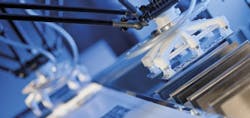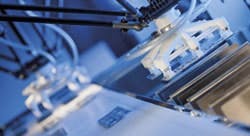"Blockbuster productions within the pharmaceutical industry are a thing of the past," says Bernd Webel, sales director for Romaco in Karlsruhe, Germany. "Due to the increasing differentiation of the worldwide markets, the batch sizes tend to be ever smaller. Different markets require different types of packaging regarding design, format, packaging size and material." Big pharma groups now outsource their production processes to contractors, creating a growing pharmaceutical service sector, he adds.
In addition to a processing division that serves various industries, Romaco's packaging division focuses on pharmaceutical and cosmetics solutions. A significant portion of Romaco's customer base is contract packers, which need quick response times and high flexibility in their machines, Webel says. There is also considerable cost pressure. Packers are trying to reduce their costs to improve their small margins. "One way to do this is automation."
About 450 employees support and supply customers in 180 countries, with more than 50,000 machines in use around the world. In the packaging division, machines are divided into several different brands. Core competencies include Noack blister machines, Siebler heat-sealing machines for manufacturing strip packaging, and Bosspak counting technology for putting tablets and capsules into bottles. Those three brands are made at Romaco's headquarters. Another facility in Bologna, Italy, makes Promatic cartoners and case packers; Unipac tube filling systems; and Macofar lines for filling liquids, powders and capsules.
A lot of the focus in packaging lately has been on improving changeover times between products. Every minute of production counts, Webel emphasizes. "Now we're helping by improving setup times for the machines," he says.
Because of the complexity, more automation is being incorporated into the packaging process. "Mechanical systems are being replaced by robotics," Webel says, noting that robots have become more common in the industry in general. "They're still expensive, but they're becoming more accessible."
Romaco has found the need to turn to robotics for packaging into strip packs, for example. Strip packs, which are four-sided, sealed foil packs used to package solid pharmaceuticals, such as tablets or effervescents, are difficult to handle, Webel says. Unlike blister packs, strips are very flexible, making them harder to deal with. "In the past, we've done it mechanically," he says. "But that's not acceptable anymore. Instead of an inflexible mechanical system, we've put in place a robotic system."
The Siebler FlexTrans strip packaging systems now incorporate a line of up to six delta robots. "We developed it on our own, using FlexPickers from ABB," Webel says. "ABB says it's the fastest packaging solution they've ever made." The FlexTrans FT 2/900 is the world's fastest transfer unit for pharmaceutical and medical strip packaging, he adds.
Once the products have been sealed in coated aluminum foil, the strip packaging is perforated and cut to the required size. "The Siebler FlexTrans FT robotic transfer station then transports the finished strips to a Romaco Promatic cartoner," Webel explains. "Up to six pick-and-place robots carry and stack the sealed strip packs at a high speed rate of up to 900 packs per minute. The stacked strips are directly transferred to the bucket chain of the cartoner. The robot-controlled direct transfer station therefore eliminates the need for complex stacking stations."
Thanks to the targeted integration of robotics, quick format changeovers are possible on strip packaging lines for the first time, Webel notes. "Owing to the servo control principle, the robot grippers can handle tablet strips in a variety of sizes and formats — from strips of 10 for clinical needs to single packs for promotional needs," he says. "The robot-controlled systems themselves are virtually maintenance-free and work without any format tools, leading to much lower costs for operation."
Flexibility is key in several of Romaco's recent automation advances. "State-of-the-art packaging technology has to offer excellent OEE values and prove itself absolutely flexible," Webel says. "Nowadays, standard batch sizes require frequent product and format changeovers. These should be carried out in the shortest time possible."
QuickTransfer — a servo-controlled robotic transfer station — passes the blister packs directly to the automatic stacking station. This station immediately places them into the bucket chain of the cartoner, which then packs the blisters into folding cartons. A total of 17 servo-controlled drives are integrated in the blister line. QuickAdjust is an automatic station control system that adjusts for any variations in foil characteristics automatically.
Romaco is trying to make every process not only fast, but highly repeatable. "In an ideal world, you could just push a button for production," Webel says.
Operator influence has become much less than it was 20–30 years ago, according to Webel. "Mechanical adjustments on the machines have been automated completely," he says. "Electric devices are detecting the location of the blisters, and no operator input is necessary anymore."
For the future, Romaco will be looking to reduce mechanics even more, Webel says, incorporating more automation to create even simpler solutions.
About the Author
Aaron Hand
Aaron Hand

Leaders relevant to this article:



